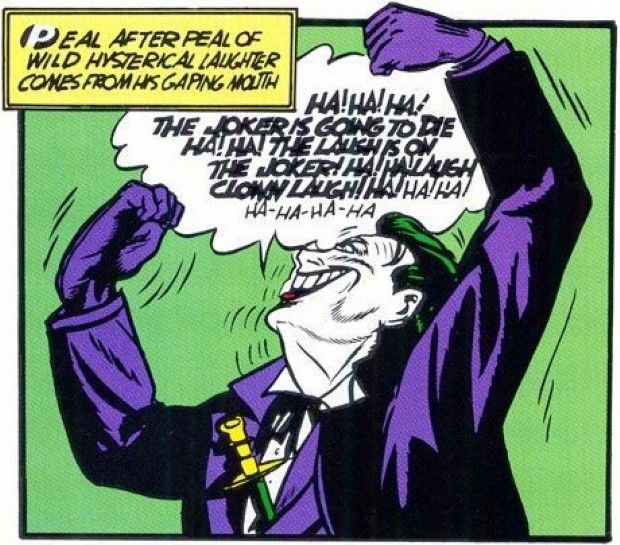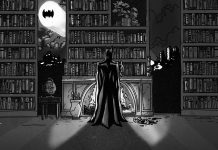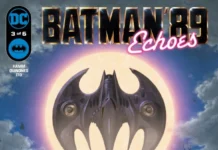PREVIOUS: A Joker’s Dozen, Part 1
One of the touchstones of The Joker’s interpretation in comics is the first dozen stories featuring the Joker that follow his introduction as a cold blooded killer and his transformation into a clever prankster that would bedevil Batman over the years without falling prey to the morality police. There are a dozen stories that make up this initial introduction, so 10 parts are to follow. – Robert Reineke
 The Story: “The Joker Returns” from BATMAN #1 (Vol. 1), 1940
The Story: “The Joker Returns” from BATMAN #1 (Vol. 1), 1940
The Return: The Joker uses chemicals in false teeth to create an explosive device to bust out of jail.
The Plot: The Joker breaks out of prison, steals gems, and kills their owners and city leaders.
Body Count: Four Seven (1 with poison dart in phone earpiece, 1 by off panel poisoning, 1 with poisoned, sharp edged playing cards, and 4 by gunshot).
Best Kill: Poison dart in the phone propelled by the Joker’s voice!
The Joker’s Running Body Count: 11
Other Mayhem: Blows up jail and injures at least two police officers according to radio report, uses paralyzing gas on a museum full of policemen, knocks out Batman with an ax to the head, and pushes Robin off a roof.
The Outthink: Bruce Wayne suggests to Gordon that he plant an article in the paper regarding a famous gem to lure the Joker to a trap.
The Comeuppance: The Joker stabs himself in a fight with Batman and Robin.
Bill Finger wastes no time getting The Joker out of jail in the second story. Again relying on the established idea that the Joker is a chemical genius, he has a contingency plan in place. The resulting explosion is depicted very violently with at least one body shown strewn in the rubble. The Joker then returns to his graveyard hideout in the middle of the night, again undead symbolism, to plot again. And, while we’re at it, does The Joker ever sleep? The bags under his eyes in his initial appearance and his manic demeanor would argue otherwise.
The rest of the plot is fairly similar to the initial story. The Joker strikes at a government official, the Chief of Police, and someone who speaks against him, in this case a public reform leader the flipside of a gangster. He also steals another gem leaving a dead owner. And he pulls his first real gag, the theft of a painting with a Joker card left in its place. Above all else, The Joker simply can not pull an anonymous crime.
Mid-way through the story, The Joker attempts to rob a gem studded necklace from a museum. He gasses some guards non-fatally, Bill Finger is careful to show the Joker venom is limited to injections at this point, in what might be an influence on BATMAN (‘89). He also emerges from a sarcophagus, again with the undead symbolism, and bests Batman in a fight It’s clear that The Joker, unlike later appearances, is a formidable match for Batman even when the plan is figured out. And, for the first time, The Joker laughs as he’s about to bury an ax in Batman’s skull.
ALSO READ: Bat-Timeline – “Batman in 1940” by Bill “Jett” Ramey
The idea of baiting a trap in the newspaper will be recur quite a bit in Joker stories over the years. Perhaps its notable that it’s Bruce Wayne that suggests it to Gordon. It won’t be long before the Bruce Wayne/Commissioner Gordon relationship is replaced by a Batman/Commissioner Gordon relationship. And The Joker falls for it in a scene that tells quite a bit about his character. He quite literally obsesses over adding another “pretty jewel” to his collection. It certainly appears that there’s nothing rational about his crimes, he steals jewels because they’re pretty, not because they’re valuable.

They could have ended the story there and I’ve no doubt that at the very least Matt Wagner would be recreating the story in a mini-series. Instead, knowing a good thing when they saw it, a last panel was added giving The Joker a reprieve from death. And it wouldn’t take long for him to reappear. – Robert Reineke










